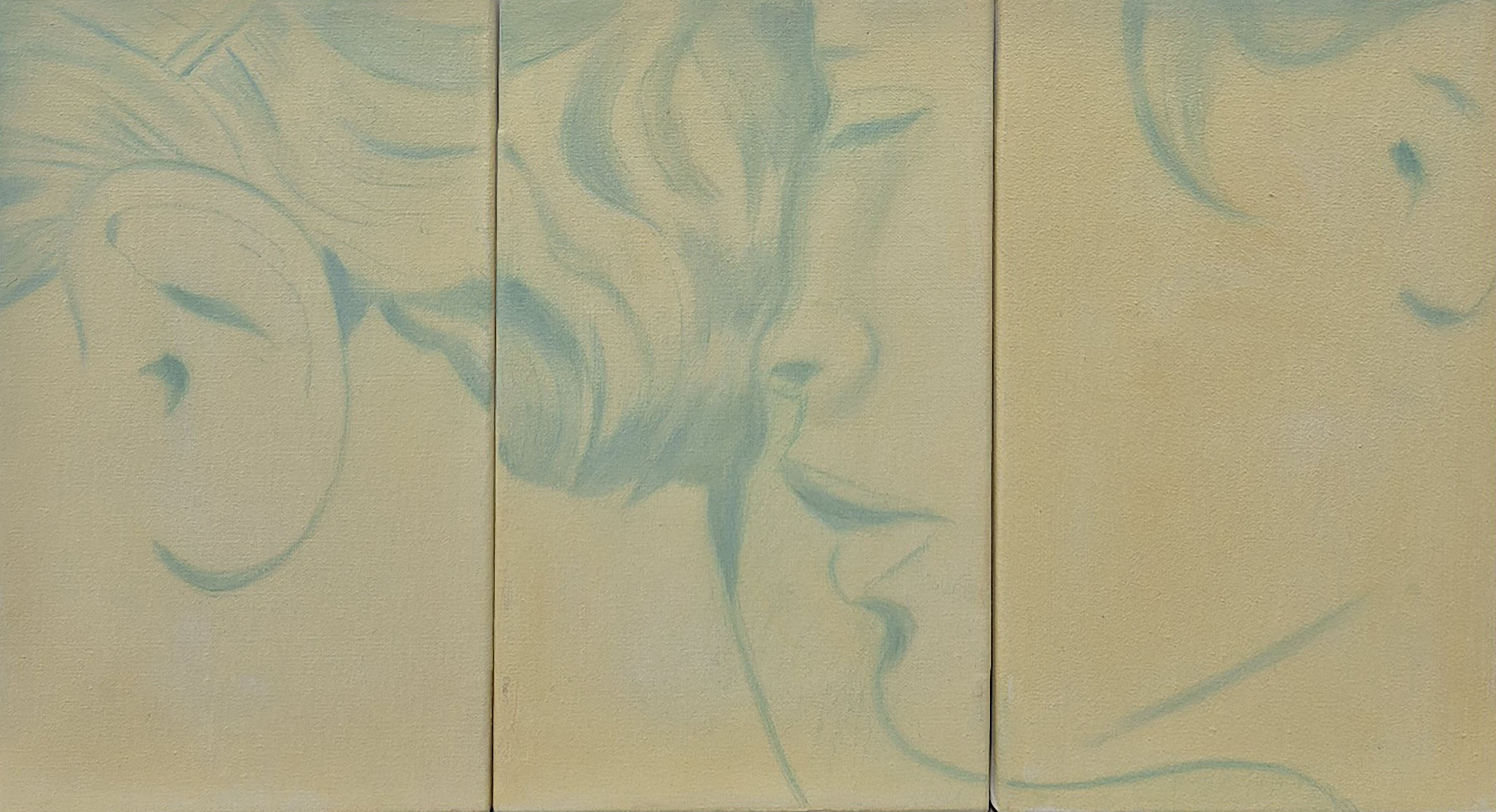Vanessa da Silva & Maya Weishof: 당신의 입이 이상한 단어들의 모양들을 담기를
| [GALLERIES] Duarte Sequeira
2023.1.28 – 3. 11
바네사 다 실바, 마야 웨이쇼프

“이상한 것들을 가져오세요. 새로운 것들을 가지고 오세요.
아주 오래된 것들이 당신의 손 안에 들어오도록 하세요. 당신이 모르는 것들이 당신의 눈에 들어오도록 하세요.
사막의 모래가 당신의 발을 굳히게 하세요. 당신의 발의 아치가 산을 이루도록 하세요.
당신의 손 끝이 가리키는 길이 당신의 지도가 되게 하세요. 그리고 당신의 손금이 당신이 가는 길이 되게 하세요.”
Ursula K. Le Guin

프랑스의 철학자 Maurice Merleau-Ponty에 의하면, 우리가 세상을 이해하고 경험하는 방법으로서의 현상학은 충 분히 체현된다. 정신과 육체 사이의 관련성의 틀 밖에서의 인식에 관한 이해는 있을 수 없다: 우리의 이성에 여과된 우리 자신의 로고스 안에서 모든 것은 우리의 오감을 통해 이루어지고, 그런 다음 종합을, 그리고는 정의를 찾는다. 강렬한 표현주의적 페인팅과 구불구불한 생물 형태를 연상시키는 조각들이 결합된 브라질 작가들 Maya Weishof 와 Vanessa da Silva의 2인전은 개인적인 것, 보편적인 것, 상징적인 것, 그리고 정신적인 것을 통하여 그 것의 가능한 편차들을 재결합하기 위해 바로 이 처음의 아이디어에서 시작한다.

Maya Weishof의 언어는 가장 다양한 자료들로 구성되어 있다: 중세 원고, 한국의 도자 장식품, 미술사, 그녀가 스튜디오에서 사용하는 그녀의 개인적인 다기 세트, 그리고 그녀의 삶 속에서 그녀가 마주친 신체들. 그녀의 페인 팅의 주인공으로서 재결합되고 승화된 다양한 요소들은, 그녀가 거의 세속적이라고 부르지만 부피의 시적인 암시 를 가능하게 하는 기술적인 결합인 유화와 파스텔의 병치로 창조된 빛과 그림자를 통해 주조된다. Maya의 페인 팅에서는 성스러운 것과 일상적인 것이 정의되지 않고 국한되지 않지만 열린 결말인 연속적인 스토리텔링에 결합되어 함께 섞인다: 이것이 사적인 집의 환경 안의 두 신체로, 또는 신비주의적인 영역의 관문을 여는 눈이 가슴 사 이에 있는 목이 베어진 여자의 상반신으로 번역되던 간에, 작가는 항상 마술적인 상징의 무한한 우화를 조사하면 서 일상적인 것의 시적인 차원을 절대 잊지 않고 신화와 동시에 일상 생활을 포괄하는 캐릭터를 창조한다. 이 전 시의 핵심적인 작품들 중의 한 점에서 Rodin의 조각 걸작을 상기시키는, 포옹하는 것 같은 두 연인이 키스하는 모 습을 볼 수 있는데, 이것은 파리 Cite Internationale des Artistes에서 한 Maya의 가장 최근 레지던시의 참고 결실이다. 두 신체가 대부분의 공간을 차지하고 있고 그들의 움직임은 작가의 전기적인 참고 자료들 중 가장 사랑하는 요소인 Naples의 화산인 Vesuvio 산을 볼 수 있는 자연 배경의 곡선과 이어진다. 회화적인 프레임에서 보면 불이 밝혀진 원고의 미학적 규범을 재해석하면서 여러 가지의 다채로운 새들이 공간을 채우고 있다.

다른 작품들에서는 신체가 종종 목이 베어져 있거나 반대로 몸이 없는 얼굴들을 볼 수 있고, 인간의 피부는 항상 푸른색, 오렌지색, 녹색, 붉은색과 같은 가장 다양한 색채의 선택지를 바탕으로 칠해짐으로써 그들이 우리일 수도 있는 것만큼 고대 동화 속의 캐릭터일 수도 있다는 가능성과의 이러한 계속되는 대화를 강요한다. 때로는 꽃과 동물들로 장식된 아 름답고 상세한 회화적인 프레임에 둘러싸여, 다른 때에는 함께 꿰매진 다양한 작품들의 선택된 부분들로 구성되 어, Maya의 내레이션은 몽상적인 것을 건드림으로써 우리를 이러한 꿈 같은 이야기 속으로 들어오게 하고 일부가 되도록 초대한다. 그들은 덧없는 것과 공상적인 것을 포착해 끝없는 공존을 가능하게 하는 대화를 만들어낸다.

우리는 Vanessa da Silva의 조각 작품을 접하게 되면 형상을 버리게 된다: Maya의 표현주의적인 페인팅을 장식했던 동일한 부드러움과 구불구불함은 이제 우리 자신의 이중성의 본질을 탐구하고, 정신과 육체가 결합하고 재 결합하는 새로 발견된 암호들과 규범들로 번역된다. 이 새로운 작품의 영감은 육체에 비한 정신의 우월성에 대 한 깨달음에 의한 이원적인 접근의 반영 -더 정확히 말하면 거부-이다: “고대 사람들은 머리가 마음과 청렴한 삶 의 비옥한 본질을 담고 있는 반면, 이성과 정신은 심장과 가슴에 있다고 여겼다” 작가는 말한다. 이전에는, 머리 가 무의식 또는 인간의 의식을 상징했을 것이다 -하지만, 세상을 이해하는 우리의 주요한 도구인 느끼고, 만지고, 냄새를 맡는 육체의 실험적인 능력은 분리된 독립체로 너무 자주 간주되는 의식 그리고 마음과 분리할 수 없다. Vanessa의 탐구는 조각의 중심에 색소가 혼합되고 마지막 층 아래에 부드러운 파스텔을 넣는 것을 통해 공식적 으로 만들어진다: 이 색채는 내부에서 드러나고, 우리와 세계 사이의, 머리와 육체 사이의, 로고스와 우주 사이의 전형적인 연결성에 대한 계시적인 전달자로서 다가온다 –Nietzsche의 모든 것들에 대한 더욱 남성적인 관점에 대 응하여 Lucy Irigaray가 현실에 대한 부드러운 이해를 옹호할 때 단언했을 것처럼. 작품들의 제목 또한 우리가 세 계 안에서의 끊임없는 되어짐의 과정에 대한 더 나아간 조사를 암시한다: “순환 속에서”, “영원한 경계성”, 그리고 “초월적인 붕괴”는 모두 고정시키려는 시도가 무한한 춤의 결과로서만 존재하는, 끊임없는 변화의 상태에 대한 암 시이다. 철제 받침대 위에 우아하게 서 있는 Vanessa의 생물 형태를 연상시키는 조각들은 정신과 이성을 연결하 고, 교환하고, 해독하고, 변동하고, 세상 만사를 이해하도록 하는 “경험의 영구적인 상태 그리고 세상을 향한 공감 성의 구성 요소”로 우리의 신체를 재고하도록 우리를 초대한다.

Maya Weishof와 Vanessa da Silva의 작품들은 함께 조합했을 때, 인간과 세속적인 것, 그리고 영적인 것과 일상 적인 것을 분류화와 무균성 분별의 모더니즘 패러다임을 넘어 심오하게 상호 연결된 일체로 기우는 우리의 지각의 양식을 다시 고려하도록 하는 초대이다. 그들은 우리의 현상학적인 도구를 이해하는 고대의 원형을 상기시켜,
-아마도- 존재론적인 차원으로 전환시키고 우리가 누구인지, 그리고 우리가 어느 이야기의 일부분인지 재고하도 록 제안한다. 전시 제목 “당신의 입이 이상한 단어들의 모양들을 담기를”은 Ursual K. Le Guin의 시에서 발췌한 것으로, 이해의 새로운 방향을 위한 중심 사상을 설정한다: 가끔은 가장 이상한 단어들과 가장 묘한 조합들이 인생 을 해석하는, 계속되는 여행을 향해 가도록 우리를 도와주는 계시를 담고 있는 유일한 것들이다.
Text written by Valentina Buzzi

두아르트 스퀘이라
서울시 강남구 도산대로 54길 27 2층
02 6953 0553











